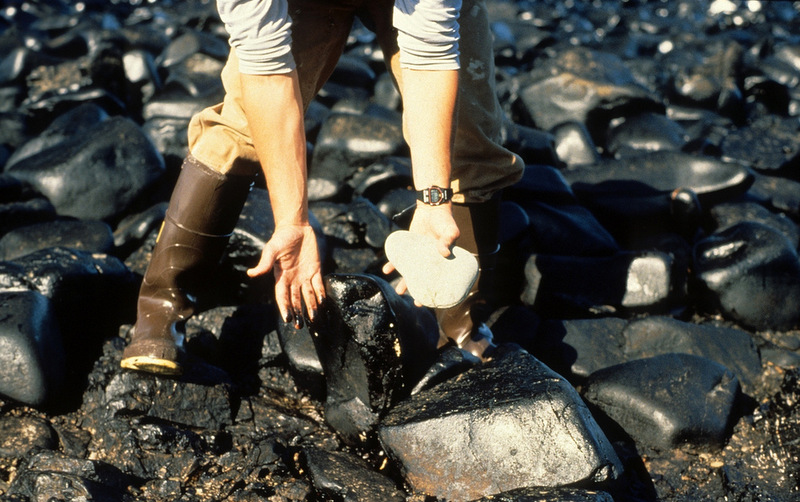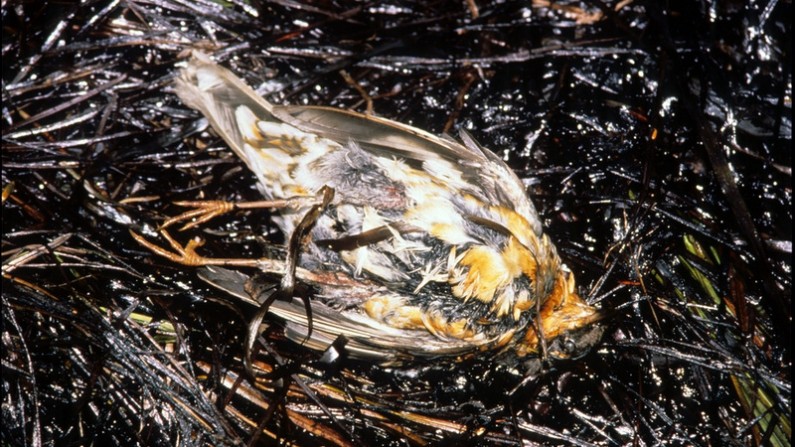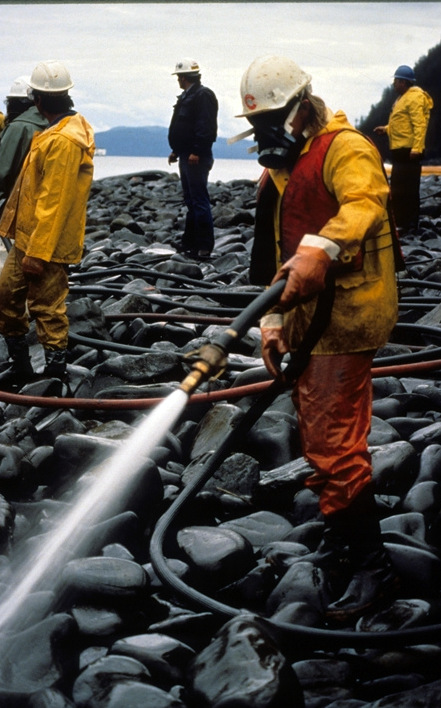
Though 25 years have passed since the infamous Exxon Valdez oil tanker ran aground at Bligh Reef near Prince William Sound, Alaska, some of the affected beaches, animals and industries are still struggling with the lingering effects of what was once deemed the largest oil spill in North American history.
About 11 million gallons of toxic crude oil — enough to fill 17 Olympic-sized swimming pools — poured out of a 986-foot vessel on March 24, 1989, and spread over more than 1,300 miles of shoreline. New reports indicate that thousands of gallons of oil still remain on the beaches and in the water, and some animal species populations have yet to fully recover from the spill.
According to the Exxon Valdez Oil Spill Trustee Council, a group formed as part of a legal settlement between the State of Alaska, the U.S. federal government and Exxon to develop research, restoration and conservation plans for the spill area, the reason the oil continues to exist in the area and remains as toxic as the day of the spill, is because the oil spilled in an area that experts refer to as a closed ecological system.
In other words, although thousand-member cleanup crews worked to clean the spill-affected beaches from 1989 to 1994, the remaining oil isn’t disappearing through the natural processes like many predicted it would. This is because Prince William Sound doesn’t see much of a tide change, if any, and there is an absence of big, crashing waves.
Without changing tides and powerful waves slapping the rocky shores and breaking up the oil deposits, the oil had time to seep into the sand, instead of being carried out into the ocean as tiny, less-harmful oil droplets that biodegrade faster than large clumps of oil, thanks to oil-hungry microbes in the water.

While the exact figures of how much oil currently remains due to the 1989 oil spill are not known, the Exxon Valdez Trustee Council reported in 2009 that at least 21,000 gallons of oil remained, with some of the oil being found as far as 450 miles away from the spill site.
Since the oil in the area is believed to be decreasing at a rate between 0 and 4 percent annually, it’s estimated that the remaining oil will take decades to weaken in toxicity and possibly centuries to disappear entirely.
Oil is very similar to mayonnaise, according to Gail Irvine, a marine ecologist with the U.S. Geological Survey and lead researcher on a new study examining what factors have contributed to the oil’s staying power.
“When oil forms into the foam, the outside is weathering, but the inside isn’t,” Irvine said, explaining that like mayonnaise left out on the counter, the surface of oil will crust over, while the inside will retain its goopy appearance.
Irvine said that when the millions of gallons of oil spilled into the 1,300 miles of rocky beaches, the crusty coating allowed the oil to “hide” between and under the boulders and cobblestones. The biggest takeaway, she said, is that a cleanup effort after an oil spill doesn’t just consist of monitoring the environment for a few weeks or months, but for years or even decades.
Cleanup efforts may have been dismantled in 1994, but since environmental groups were persistent in demanding that the impact from the spill continue to be monitored, scientists have been able to track the efforts of wildlife to rebound from the spill.
Rebirth of an ecosystem
The World Wildlife Fund estimated that 250,000 seabirds, 4,000 sea otters, 250 bald eagles and more than 20 orca whales were killed in the first year after the spill, making the 1989 Exxon Valdez oil spill one of the most damaging spills from an environmental perspective, ever.
Thousands more animals died in subsequent years, as they struggled to find food, consumed oil and lost body heat because their fur or feathers were coated in oil. Because the oil spill was also responsible for killing salmon and herring eggs, and the carcasses of sea life typically sink, the exact number of animals killed is not known.
Of the 20 or more nearshore species of animals affected, not all have recovered. Many are still struggling with the lingering effects of the oil, but a new report from the U.S. Geological Survey found that some species, like sea otters, have returned to pre-spill numbers.
Images of sea otters slathered in oil quickly became an iconic visual representation of the severity of the oil spill, so news of their return is particularly exciting for many. Sea otters had been hit particularly hard because a lot of the oil settled in the ocean sediment where the animals dig for clams — a staple of their diet.
Sea otters also lost a lot of their body heat when covered in oil, resulting in some dying from hypothermia. Others died from liver damage they sustained after ingesting oil while trying to groom themselves, as well as eating tainted clams.
“Although recovery timelines varied widely among species, our work shows that recovery of species vulnerable to long-term effects of oil spills can take decades,” said lead author of the study, Brenda Ballachey, a research biologist with the U.S. Geological Survey. “For sea otters, we began to see signs of recovery in the years leading up to 2009, two decades after the spill, and the most recent results from 2011 to 2013 are consistent with recovery as defined by the Exxon Valdez Oil Spill Trustee Council.”
While the general population of sea otters has increased to pre-spill levels, it should be noted that sea otter populations in areas most affected by the oil spill have not recovered as quickly.
‘Not recovering’
Unfortunately, not all species have been as lucky as the sea otter since the oil spill. The Pacific herring, for one, has been listed as “not recovering.” This is particularly devastating to the ecosystem because the fish is a staple food for species such as salmon, seabirds, sea otters and whales.

According to Scott Pegau, research program manager for the Oil Spill Recovery Institute in Cordova, Alaska, the herring population went from about 120 metric tons before the spill, to less than 30 metric tons four years after the spill. Though scientists are not sure if the oil is solely responsible for the species’ inability to thrive again, experts point out that the fish rely on zooplankton to survive, and unfortunately, zooplankton numbers plunged three years after the oil spill.
Pigeon guillemots have also struggled to bounce back to pre-oil spill levels. Like the herring, the guillemot’s decline is not entirely a direct result of the oil spill, as river otters, mink and other predators have been eating guillemot eggs since the incident. Scientists believe these predators are eating the eggs instead of foraging for food on the oil-soaked beaches.
Orca whale populations have also struggled to return to their pre-oil levels.
There has been a human toll, as well. Many who worked in the fishing industry reported that financial and emotional stress associated with the oil spill led to the failure of marriages and losses of fishing boats and homes, as fishermen were unable to earn as much as they had before the spill.
“The bottom fell out of the price of fish,” said fisherman Bernie Culbertson, explaining that the price for pink salmon went from 80 cents per pound to 8 cents per pound after the spill, when consumers began to eat more farm fish or tuna, fearing wild salmon would be tainted with oil.
Lesson learned?
The 1989 Exxon Valdez spill may have occurred 25 years ago, been replaced as the worst oil spill in U.S. history and not even rank in the top 50 of the world’s worst oil spills, but it is responsible for a slew of changes — from how oil spills are handled, to the type of equipment oil tankers are required to have on board.
Though some have blamed the spill on the ship’s expert pilot William Murphy’s possible intoxication, scientists and former military personnel point out there was a multitude of human and technological errors that led to the spill.
For instance, Murphy instructed the vessel’s captain to leave the shipping lanes to avoid icebergs, which were common in the Prince William Sound area. The only problem was that the 986-foot ship needed to return back into the shipping lanes before it reached Bligh Reef. In order to get back into the shipping lane, the vessel needed to make a hard right turn, which would have been difficult even for an experienced captain. But the vessel was left in the hands of a lesser-experienced third mate, who failed to make the turn in time. As a result, the ship slammed into the reef, damaging eight of its 11 cargo tanks.
Rick Hepburn, P.E. Captain, U.S. Navy (Ret.), said failing to miss the reef was the most immediate and obvious failure. Consequently, it led to a discussion about building vessels that didn’t automatically leak if they were damaged.
Hepburn said this oil spill led to a discussion about requiring double hulls instead of just one. This could ensure that if one was damaged, there would be a backup that would hopefully stop a leak. Per a U.S. mandate after the spill, all ships in Prince William Sound are required to have double hulls by 2015.
Even if the ship had been in the shipping lanes, experts say there was inadequate radar technology alerting the captain about possible reefs in the area. Paired with the fact that the city of Valdez had cut its Coast Guard station crews by about half and replaced them with technology that was not capable of detecting Bligh Reef, it was a recipe for disaster. In response, GPS systems with improved radar are now equipped on the vessels.
At the time of the spill, the official response strategy was to contain the oil as close to the ship as possible and then remove it. But the oil from the Exxon Valdez rapidly escaped from within the vicinity of the ship. In response, the U.S. Legislature passed the Oil Pollution Act of 1990, which allowed for tankers to be towed away by tugboats and improved oil spill cleanup technologies.

